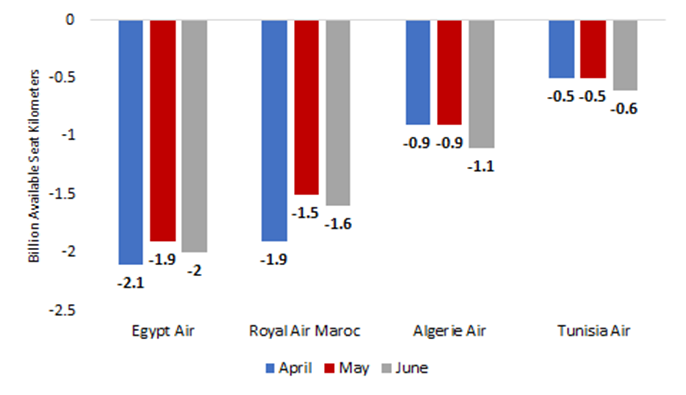In a nutshell
Although the effects of the first wave of Covid-19 have been devastating for the tourism sector of MENA countries, a second wave could be catastrophic.
Direct and indirect employment in tourism is historically high in countries such as Egypt, Morocco and Tunisia; support will be needed for parts of these countries where the sector has been hit hard by unemployment.
Since the tourism sector in most developing countries is linked closely to international flights, recovery will be dependent on the opening of international borders and the resumption of regular commercial flights, which may not happen for two or three years.
Tourism is an important pillar of the economies of the Middle East and North Africa (MENA), accounting for about 5.3% of GDP growth and 6.7 million jobs across the region. The unknown duration and scope of the pandemic and the worldwide panic accompanying it have caused a tourism crisis (Ben Youssef et al, 2020).
The effects of Covid-19 on the tourism sector can be examined in the context of two waves of the infection. Although the impact of the first wave has been devastating for the tourism sector in MENA countries, a second wave could be catastrophic.
The impact of the first wave of Covid-19 on tourism in MENA countries
The worldwide lockdown during the first wave of Covid-19 was imposed to prevent the spread of the virus. It affected tourism across the world including MENA countries where the effects were particular dire for Egypt, Lebanon, Morocco and Tunisia, all of which rely very heavily on tourism.
According to the United Nations World Tourism Organization (UNWTO), the number of tourist arrivals has fallen by about 57% in the Middle East and by about 62% in North Africa. The cancellation of major events due to take place in the region, such as Dubai EXPO 2020 and the annual Haj pilgrimage in Saudi Arabia, expected to attract 25 million visitors and two million religious tourists respectively, have had devastating effects on the economies of the region. In the first nine months of 2020, Tunisia saw its tourism revenue drop by 60%, and it is expected that by the end of 2020, revenues will be down by 70%.
The aviation sector is one of the most badly affected industries. The International Air Transport Association (IATA) has warned that air traffic in the region is likely to decrease by more than half this year. Airline companies are being affected as severely as in other parts of the world.
According to a report by the African Airlines Association (AFRAA), several carriers have suffered badly. Figure 1 shows that based on the available seat to kilometres ratio, Egypt Air has lost two billion, Royal Air Maroc 1.6 billion, Air Algeria 1.1 billion and Tunisair (which has a smaller fleet of aircraft) 600 million. Air Algeria’s financial losses could reach 89 billion dinars by the end of 2020 and Qatar Airways, which has experienced a drastic drop in demand due to the crisis, has issued warnings about staff reductions.
Figure 1: Decrease in total available seat kilometres in April, May and June 2020
(Source: AFRAA)
Re-opening of tourism activities accompanied by security and health measures
Some MENA countries made efforts to attract tourists during the summer. Tunisia re-opened its land, sea and air borders on 27 June, allowing tourists to enter the country based on a colour-coded risk assessment system. Egypt resumed its tourism activities on 1 July under strict hygiene measures and controls on numbers of tourist arrivals, resulting in the arrival of around 6,000 tourists, mostly from Switzerland, Ukraine and Belarus.
Dubai, the most popular tourist destination in the United Arab Emirates began accepting tourists on 7 July. Haj pilgrims were restricted to residents of Saudi Arabia. Morocco embarked on a gradual re-opening of its borders on 14 July, subject to strict rules.
Several organisations have developed safety protocols and certifications to try to ensure the survival of the tourism sector and the safety of tourists. They emphasise the importance of restoring tourists’ confidence through the provision of safety and security protocols to reduce the risk of infection and spread of Covid-19 via the tourism sector.
A second wave of Covid-19 could paralyse tourism in MENA countries
A second wave of coronavirus infections is a huge threat to the recovery of tourism in the region. The strict and compulsory safety protocols developed by UNTWO and other tourism organisations are not facilitating rapid recovery of the tourism sector. While this sector is considered a cornerstone of MENA economies, it is likely to be responsible for a second wave of Covid-19. At the beginning of the autumn, the number of cases rose. While the first wave caused many devastating effects, a second wave of Covid-19 could be disastrous for the sector.
Some MENA countries, such as Jordan, Lebanon, Morocco and Tunisia have recorded higher numbers of Covid-19 cases in recent days. The effects on the tourism sector are likely to worsen, leading to the bankruptcy of many businesses by the end of the year.
Travel agencies and airline companies are suffering huge losses despite reducing their activities and adjusting staff numbers to try to cut costs. Employment in the tourism sector in MENA countries will continue to deteriorate as the situation develops, and any recovery will take a long time. While Egypt recently announced no new Covid-19 cases related to tourists. the tourism sector in the country remains fragile.
Measures such as a 14-day quarantine on arrival at a destination have reduced tourism and grounded flights. Some airlines are offering pre-flight testing to try to avoid mandatory 14-day quarantines. Testing of passengers will not stop the spread of the virus but should limit it. MENA airlines need to implement measures to revive and build passenger confidence; airport testing is one possible solution.
Conclusion
The relaunch of some tourism activities is showing that recovery in this sector will take time; a second wave could lead to many businesses going bankrupt and huge rises in unemployment.
Any recovery of tourism will require support for employment in this region where unemployment in the sector is particularly high following the Covid-19 crisis. Direct and indirect employment in tourism is historically high in countries such as Egypt, Morocco and Tunisia.
In addition, domestic travel should be promoted by targeted policies to ease the psychological impact of confinement. Public interventions such as holiday vouchers should be introduced for travellers of all ages. Finally, it will be crucial to restore consumer confidence in all types of travel, and airlines should adopt pre-flight testing to avoid compulsory quarantine periods.
Since the tourism sector in most developing countries is linked closely to international flights, its recovery will be dependent on the opening of international borders and the resumption of regular commercial flights, which may not happen for two or three years.
Further reading
Adel Ben Youssef, Adelina Zeqiri and But Dedaj, B. (2020) ‘Short and Long Run Effects of Covid-19 on the Hospitality Industry and the Potential Effects on Jet Fuel Markets’, IAEE Energy Forum/Covid-19 Issue 2020.
UNWTO (2020) International Tourism and Covid-19 2020.
AFRAA (2020) AFRAA Covid-19 IMPACT ASSESSMENT II.





